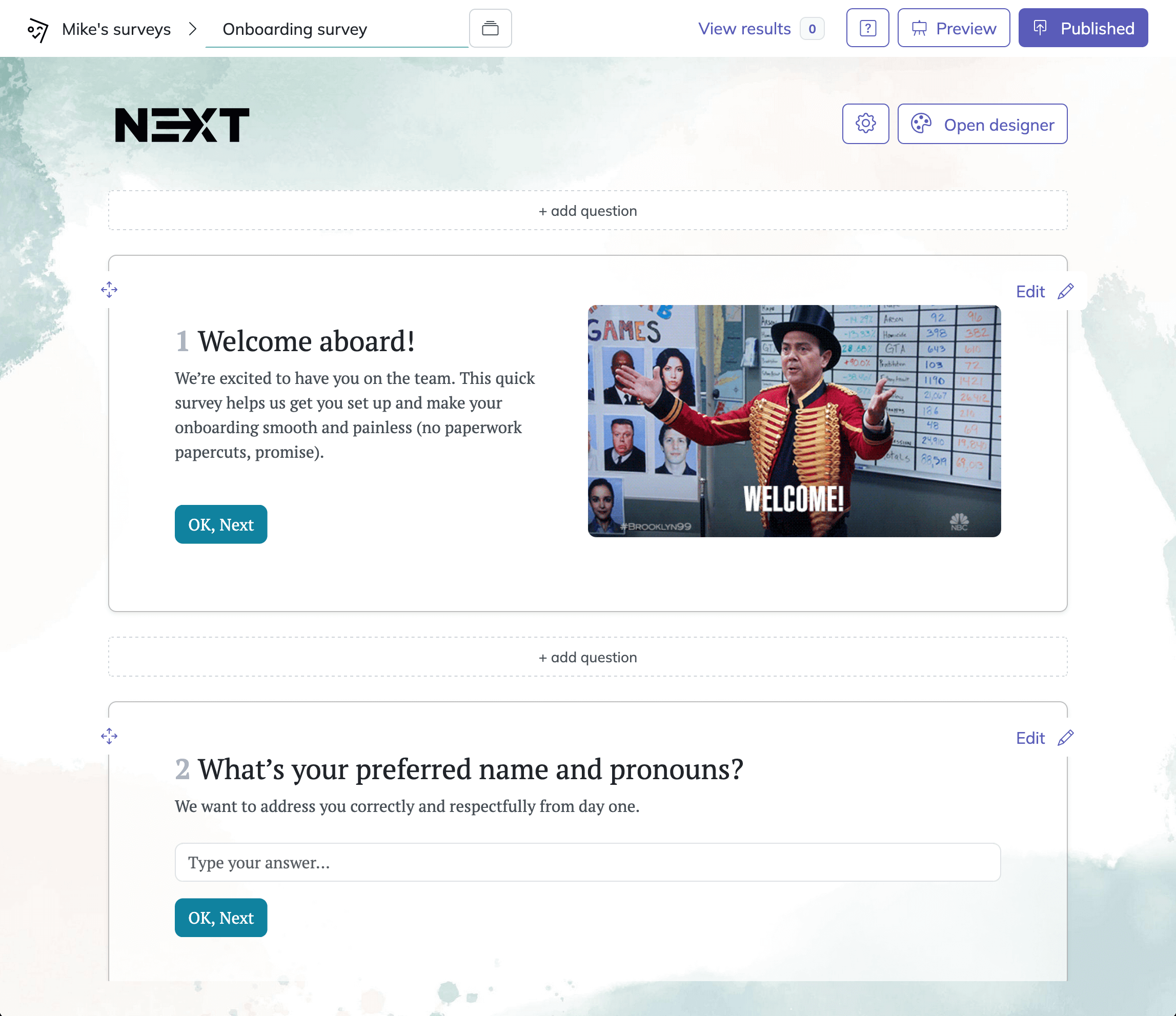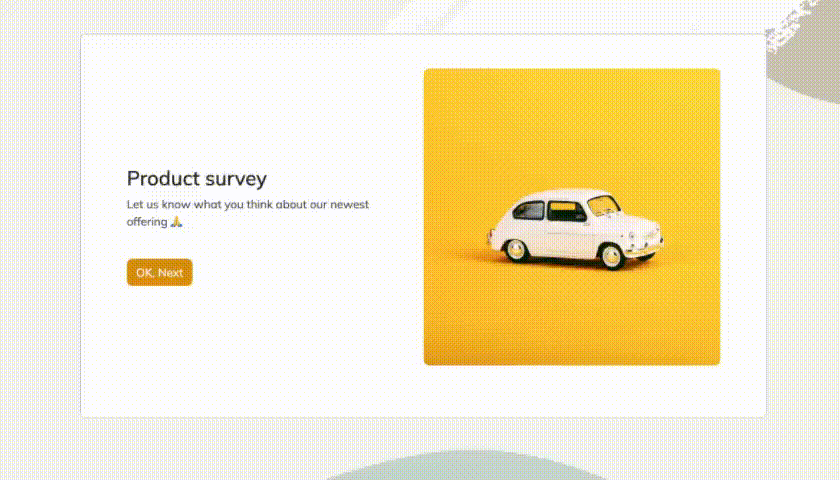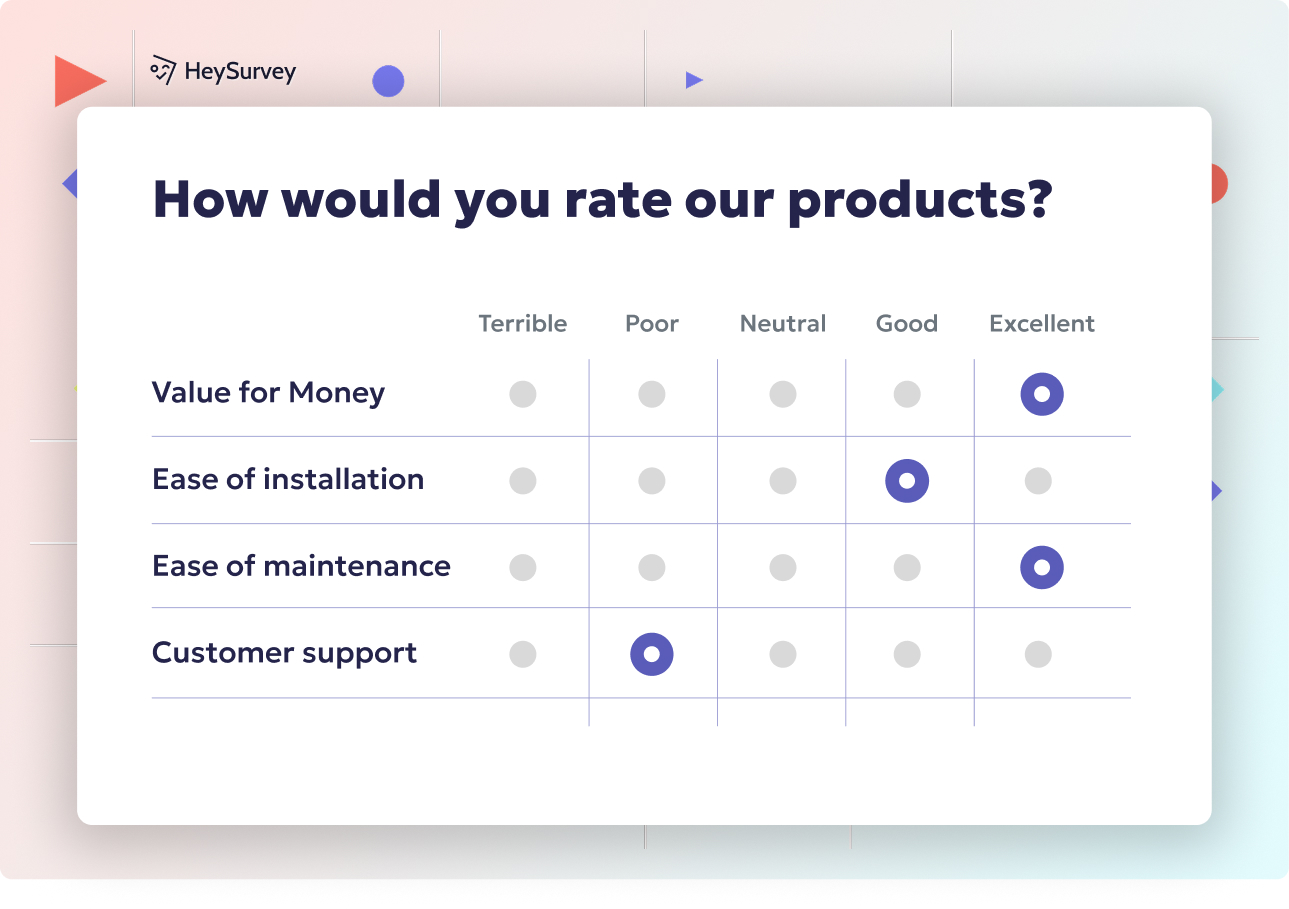31 Health and Safety Survey Questions: Types & Best Practices
Explore 35 expert health and safety survey questions across 7 types to boost workplace safety, employee feedback, and risk management.
Every organization wants a workplace where safety isn’t just a box checked, but something truly felt. Health and safety surveys are how you balance that tightrope, revealing risks before they trip you up and ensuring well-being is never a blind spot. Proactive teams lean into surveying during audits, after incidents, for new hires, and whenever a policy breathes fresh air. The payoff is huge: regulatory peace of mind, fewer accidents, trust that runs deep, and a map for smarter improvements. You’ll discover the seven essential types of surveys, each with ready-to-use questions to supercharge your workplace safety survey strategy—and yes, actionable examples are coming right up.
Workplace Safety Climate Survey
Why & When to Use
The very heart of any safe environment beats with a safety climate—the shared attitudes, beliefs, and perceptions about safety on the floor or in the office. Safety culture survey questions offer a peek into how your people feel, not just what’s on paper. If you want a pulse-check before launching big changes, or you’re prepping for a quarterly overhaul, this is your trusty tool.
Launch this when management wants to assess whether their commitment is truly visible or just a memo on the wall. It’s also a smart move as part of annual safety reviews, or if rumors of unsafe shortcuts are swirling.
Results help organizations:
- Spot gaps between leadership intent and everyday actions.
- Understand peer attitudes—because team culture trumps written rules every time.
- Lay the groundwork for targeted safety initiatives, rather than spraying a one-size-fits-all fix.
Getting honest employee safety feedback fuels a culture where everyone looks out for one another and believes management actually walks the talk. The insights aren’t just warm fuzzies—they directly tie into reducing incidents, boosting morale, and keeping that safety audit stress at bay.
5 Sample Questions
- How strongly do you agree: “Management consistently demonstrates a commitment to safety.”
- Do you feel comfortable stopping work if you notice something unsafe?
- How often do you observe coworkers following defined safety procedures?
- In your opinion, what could leadership do to show greater support for safety?
- On a scale of 1-10, how would you rate the overall safety climate at your workplace?
Writing Guidance
Craft your questions to highlight safety culture survey concepts—think trust, buy-in, and open dialogue. Avoid fancy jargon; the best management commitment to safety questions make everyone feel their voice matters, from the shop floor to the CEO’s office. Test questions for clarity and always leave room for open-ended comments that catch what a five-point scale can’t.
The Nordic Occupational Safety Climate Questionnaire (NOSACQ-50) is a validated tool comprising 50 items across seven dimensions, effectively measuring workplace safety climate perceptions. (bmcpsychology.biomedcentral.com)

Creating your health and safety survey with HeySurvey is a breeze—even if you’ve never met the tool before. Follow these three easy steps, and you’ll be collecting valuable employee safety feedback in no time!
Step 1: Create a New Survey
- Open HeySurvey and choose Create Survey.
- Pick a pre-built template that fits your survey type (for example, a Workplace Safety Climate Survey). This gives you a ready-made structure you can tweak.
- Alternatively, start from a blank page if you want full control.
Voilà! Your new survey shell is ready to be filled.
Step 2: Add Questions
- Click Add Question to insert your first question.
- Select the question type that suits your needs—Likert scale for rating safety climate, multiple choice for PPE compliance, or open-ended for free feedback.
- Enter your question text, plus any instructions or descriptions.
- Mark questions as required if you need to ensure responses.
- Repeat until all relevant questions are in place. You can reorder questions by dragging them around any time.
Pro tip: mix scales and open-ended questions to get both quantifiable data and richer stories.
Step 3: Publish Survey
- Hit the Preview button to see your survey exactly how employees will. Make any visual or wording tweaks.
- When happy, click Publish to generate your survey link.
- Share this link via email, intranet, or QR code for your team to start submitting responses.
Remember—you need a HeySurvey account to publish and view results. Signing up is quick and free!
Bonus Steps for Extra Flair and Functionality
- Apply Branding: Go to the Branding panel to add your company logo and customize the colors and fonts to match your corporate style.
- Define Settings: Set start/end dates, response limits, or add a thank-you redirect URL under the Settings tab.
- Skip Logic & Branching: Use the branching feature to tailor question flow based on answers (like skipping irrelevant PPE questions if someone works remotely). This keeps surveys relevant and snappy.
With these tips, your health and safety survey won’t just collect data—it’ll engage your workforce and drive meaningful improvements. When you’re ready, click the button below to launch your survey template and get started!
Incident Reporting & Near-Miss Feedback Survey
Why & When to Use
If “nothing ever gets reported” feels suspiciously too good to be true, it probably is. A well-designed near-miss survey helps surface those “almost accidents” and nudges employees to share concerns without fear. Many hazards only get fixed when someone finally speaks up.
Organizations wheel out incident reporting barriers surveys after a sudden spike in mishaps, or just to check whether their open-door policy is actually a revolving one. Use these to benchmark and boost your reporting culture so issues get solved before they spiral.
Specific wins:
- See where reporting gets stuck (fear of blame, tricky forms, unclear process).
- Gauge understanding—do folks even know what counts as a near miss?
- Reinforce a climate where safety stories aren’t just for cautionary tales.
More reports don’t mean more danger; they mean more protective action.
5 Sample Questions
- How easy is it for you to report an incident or near-miss at work?
- Have you ever chosen NOT to report an incident? If yes, why?
- Do you believe your reports are handled confidentially?
- What, if anything, would encourage you to report near-misses more frequently?
- On a scale from 1-10, how would you rate management’s response to reported incidents?
Additional Guidance
Anchor your wording around near-miss survey questions but keep it welcoming—nobody wants a grilling. Get specific on incident reporting barriers yet allow enough leeway for unexpected feedback. This is where you uncover game-changing insights, not tick boxes.
Implementing a near-miss reporting program led to a 64% reduction in recordable accidents at a studied company. (onlinesafetytrainer.com)
Ergonomics & Physical Workspace Survey
Why & When to Use
Those mysterious backaches and tingling wrists aren’t always just “getting older.” Ergonomic assessment survey tools spot uncomfortable truths about your chairs, keyboards, and room layouts before a mountain of pain claims (and grumbling) piles up. The right questions flag everything from monitor glare to why you accidentally keep bumping into file cabinets.
Deploy a workspace safety checklist when:
- Redesigning offices or switching to hotel desks.
- Running a remote-work equipment reevaluation.
- After reports of strain injuries or when new hires join.
Addressing ergonomic issues early ensures people stay healthy, focused, and happy. The physical setup at work often influences productivity more than caffeine or pep talks ever could.
Benefits include:
- Catching mismatched furniture or equipment before complaints escalate.
- Identifying strange workstation habits that lead to injury.
- Gathering feedback that informs sensible investments—not just fancy gadgets.
You don’t solve musculoskeletal puzzles by guessing; you close the loop with sharp, honest survey responses.
5 Sample Questions
- Are your workstation and equipment comfortable for daily tasks?
- Have you experienced discomfort or pain related to your workspace in the last three months?
- Do you know how to properly adjust your chair and monitor?
- What improvements would help make your work area safer or more comfortable?
- On a scale of 1-10, how would you rate the overall ergonomics of your workspace?
More on Survey Construction
Use straightforward ergonomic assessment survey questions. Slip in a few workspace safety checklist questions to help catch everyday annoyances and not just catastrophic “ouch” moments. Employees love solutions they’ve helped design.
Personal Protective Equipment (PPE) Compliance Survey
Why & When to Use
If hardhats go missing faster than snacks in the breakroom, it’s time for a PPE survey. Any gaps in protective equipment compliance aren’t just policy violations—they’re open invitations for injury. Figuring out whether issues stem from lousy fits, forgetfulness, or lack of training is key.
This survey is your go-to:
- After launching new PPE or updating old gear.
- When non-compliance is spotted or safety audits reveal missing equipment.
- If complaints surface about uncomfortable or difficult-to-use protection.
Using these questions provides:
- A spotlight on supply chain hiccups or poor storage setups.
- Insight into whether instructions are clear and training is memorable.
- Employee feedback on real-world usability—not just what looks good in a catalog.
Peeling back the layers on PPE usage often reveals jesters, not rule-breakers—humor can point to clumsy fits or confusing signage.
5 Sample Questions
- Is the required PPE always available when you need it?
- Do you receive clear training on the correct use of PPE?
- Have you ever chosen not to use PPE? If so, what were your reasons?
- How comfortable and well-fitting do you find your assigned PPE?
- On a scale of 1-10, how would you rate overall PPE compliance in your work area?
Guidance for Wordsmiths
Make every PPE survey question practical. Don’t shy away from humor or candor—are “those goggles fogging up again?” Keep the focus locked on protective equipment compliance, and encourage specifics where possible so common gripes don’t fly under the radar.
A study found that 89% of safety professionals observed workers failing to wear required PPE, with 62% citing discomfort as the primary reason. (ehstoday.com)
Mental Health & Stress Management Survey
Why & When to Use
Sometimes, risk wears a hard hat. Other times, it wears a smile and hides until burnout strikes. Tackling well-being requires more than posters or apps—thoughtful workplace mental health survey questions reveal what employees are truly feeling.
A great employee stress questionnaire is a must:
- After big changes like restructures, layoffs, or a traumatic event.
- For regular biannual check-ins to monitor shifting stressors.
- When growing workloads or absenteeism suggest morale is sagging.
Diving into mental health surveys does wonders for well-being, retention, and the overall courage to ask for help. It also makes organizations more resilient—because teams that feel heard weather more storms.
Perks from exploring stress levels:
- Bright ideas for practical workload fixes, not just morale boosters.
- A read on actual support use—EAPs, helplines, chillout zones.
- Honest signals if people are wrestling alone or trust their managers to listen.
5 Sample Questions
- Do you feel comfortable discussing stress or mental health concerns at work?
- Have you experienced increased stress or anxiety related to your job in the past three months?
- Are you aware of the mental health resources and support services available to you?
- What changes would help reduce work-related stress or improve your mental well-being?
- On a scale of 1-10, how would you rate your current stress level at work?
Approach to Clarity
Workplace mental health survey questions should always use open language. Ditch corporate jargon. Channel empathy and curiosity—treat each response as a story, not a stat. Bravery rewards you with honesty.
Emergency Preparedness & Response Survey
Why & When to Use
When the fire alarm shrieks or the lights flicker in a storm, panicking wastes precious seconds. Sending out an emergency preparedness survey ensures that when chaos calls, staff aren’t left guessing.
Distribute these questions:
- After a drill, real-life scare, or policy update.
- Ahead of high-risk periods, like hurricane or fire season.
- During onboarding, to check awareness of alarm systems and exits.
Why it works:
- Reveals where knowledge gaps or confusion could spell disaster.
- Pinpoints needs for signage, extra training, or clearer procedures.
- Validates whether first-aid kits and emergency contacts are actually known—not just somewhere in an old manual.
A practiced evacuation is always smoother than a theoretical one, and rehearsed calm is much better than rehearsed excuses.
5 Sample Questions
- Are you familiar with the emergency evacuation routes in your work area?
- Do you know where to find the nearest fire extinguisher and first aid kit?
- How confident are you in responding to an emergency situation at work?
- Have you participated in an emergency drill in the past year?
- On a scale of 1-10, how would you rate the overall emergency preparedness of your team?
Tips for Question Design
Simple, scenario-based evacuation plan questionnaire questions work best—less abstract, more “what would you actually do?” Keep the tone helpful. Every answer can unlock real-world changes that keep everyone safe, even when (not if) the sirens wail.
Risk Perception & Hazard Awareness Survey
Why & When to Use
Some folks see risks everywhere—others whistle past the forklift. Untangling real versus perceived danger makes your risk controls smarter. A well crafted hazard awareness survey cues up fresh eyes before a risk-assessment workshop or ISO 45001 visit.
Deploy if:
- You’re prepping for compliance audits.
- It’s time for annual risk-mapping with your team.
- Employees are moving to new roles or hazardous operations.
Reports let you:
- Map out where perceptions match minor or major hazards.
- Spot dangerous “blind spots” due to overfamiliarity.
- Prioritize fixes and education where it matters most.
A dialed-in sense of risk doesn’t just prevent boo-boos—it shapes investments, training, and what gets leadership attention.
5 Sample Questions
- How confident are you in identifying hazards in your daily tasks?
- What types of hazards do you think exist in your workplace?
- Have you received adequate training on hazard recognition and risk controls?
- Are there any safety risks you feel go unnoticed or ignored here?
- On a scale of 1-10, how aware do you feel of potential workplace hazards?
Guidance for Clarity
Center your risk perception questions on common, relatable scenarios. Steer away from technical lingo that makes little sense outside an engineer’s notebook. Every answer you gather helps zap complacency and arm your team against not only obvious risks, but those that sneak up when vigilance fades.
Best Practices: Dos and Don’ts for Crafting Health & Safety Survey Questions
A survey is only as good as its design. To get the most value—and the least eye-rolling—follow these pro tips for building brilliant health and safety survey questions.
Dos:
- Keep language short, crisp, and free of muddling terms.
- Use a mix of rating scales and open-ended prompts for richer data.
- Guarantee anonymity so people feel safe sharing real feedback.
- Align questions with current legal and standards requirements.
- Always pilot test your survey to iron out misunderstandings.
Don’ts:
- Avoid leading wording that nudges staff toward “right” answers.
- Skip jargon that only safety nerds understand.
- Don’t ignore the need for honest follow-up—outline next steps.
- Never neglect roles or shifts; make sure night staff and field teams are included.
Keep your workplace safety survey cycles regular—a survey once a year won’t cut it. Survey results aren’t the end: they’re the opening act. Keep learning, keep improving, and watch your safety culture become the envy of the industry.
Health and safety survey questions, from incident reporting to emergency drills, create a workplace where every voice matters. As you roll out these surveys, remember: smart questions, honest answers, and follow-through are what transform compliance into genuine care. That’s a win for everyone, every shift.
Related Safety Survey Surveys

32 Crime Survey Questions: Types, Uses & Proven Examples
Explore 40 expertly crafted crime survey questions with sample sets to measure crime rates, publi...

32 Safety Survey Questions: Types, When & How to Use Them
Discover 30 expert safety survey questions across various types to boost workplace safety, cultur...

